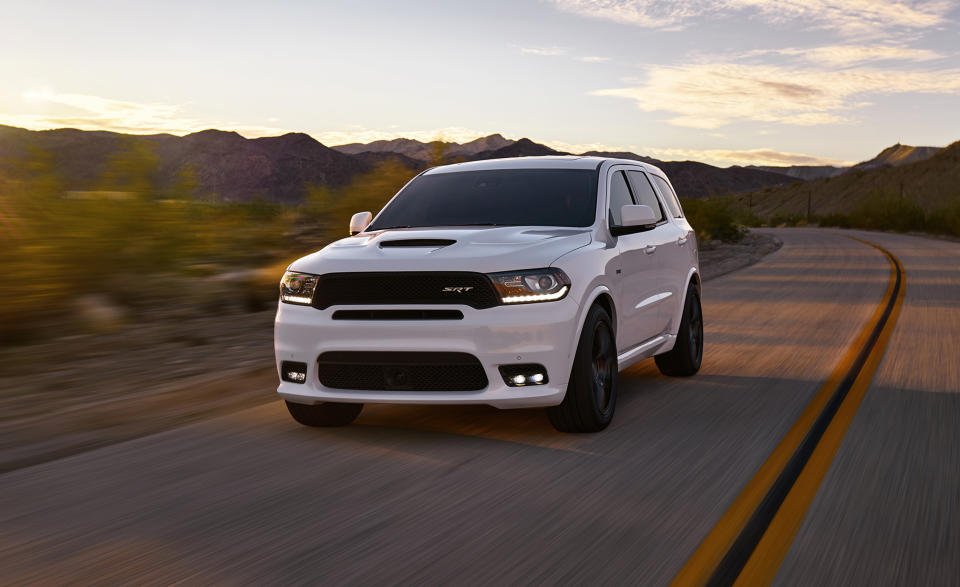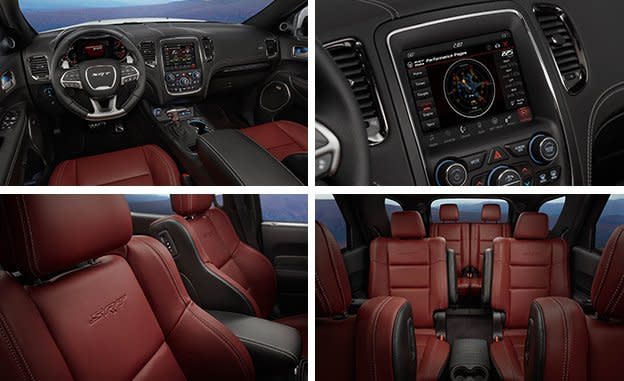2018 Dodge Durango SRT: Hi-Po Three-Row

SRT has been busy with SUVs. First, it’s dropping this six-passenger Dodge Durango SRT on the Chicago-show table like it was a six-pound, sauce-on-top Lou Malnati’s pie. And then FCA’s go-fast division is expected to unleash the Jeep Grand Cherokee Trackhawk at the New York auto show in April. If you don't like these, you probably don't like pizza, either.
SRT essentially grafted the Grand Cherokee SRT’s powertrain into this Durango. Motive force comes by way of the same pushrod 6.4-liter Hemi V-8, pumping out 475 horsepower at 6000 rpm and 470 lb-ft of torque at 4300 rpm. ZF’s ubiquitous eight-speed automatic, along with a transfer case capable of varying the torque split between the front and rear axles, shuttles that output to all four wheels. Pirelli 295/45R-20 all-season rubber is standard, but stickier Pirelli P Zero summer tires are optional. SRT says the big 6.4-liter will deliver a zero-to-60-mph time of 4.4 seconds and a quarter-mile of 12.9 seconds. But those claims come with a caveat of NHRA certification, so one can only assume those numbers are generated on a high-friction drag-strip surface, because the last Grand Cherokee SRT we tested—which, according to SRT, is 406 pounds lighter than this Dodge—returned times of 4.4 and a 13.0 seconds. Under street conditions, we expect the 5500-plus-pound Durango to sprint to 60 in 4.6 seconds on its way to a 13.4-second quarter.

The quickest of GM’s big Cadillac Escalade/Chevrolet Tahoe/GMC Yukon SUVs can’t come close to the performance we expect from the SRT Dodge. Buyers looking to better the SRT’s pace with a three-row SUV will have to look to more expensive alternatives, such as the $125,025 Mercedes-AMG GLS63. Undercutting pricier competition has long been the SRT credo with its in-house hot rods, and that hasn’t changed. Pricing is still to be determined, but we expect the Durango SRT to start just under $70,000.
The engineers didn’t stop with straight-line performance, spending many laps at Virginia International Raceway chasing handling goals. To reach the objectives, the chassis engineers installed revised bushings, slightly stiffer springs, a stouter rear anti-roll bar, and adaptive dampers for the control-arm front and multilink rear suspensions. Depending what drive mode is selected (there are eight: Street, Sport, Track, Snow, Tow, Valet, Eco, and a customizable option), the dampers adjust their firmness, and the viscous clutch in the transfer case directs as much as 70 percent of available torque rearward. (That number is in Track mode; in Snow and Tow modes, the front-to-rear torque split is 50/50.) The braking hardware is upgraded to six-piston front and four-piston rear calipers grabbing 15.0- and 13.8-inch slotted rotors.

The 6.4-liter Hemi is tuned to match the Charger SRT 392’s soundtrack. Call it throaty, menacing, or well endowed—all are fitting. There is no fake engine music pumping through the stereo here, although an active noise-canceling function kicks in when the engine switches to fuel-saving four-cylinder mode. That’s also active in Tow mode, because the loads on the engine will be greater, creating a louder cabin that could potentially lead to driver fatigue on long hauls. The SRT will tow up to 8600 pounds.
A tastefully spruced-up cabin features heavily bolstered buckets for the first- and second-row passengers, who sit in front of one of the easiest-to-access third rows on the market. The SRT is strictly a six-seater, and an optional second-row console takes the space of a middle seating position. Low-gloss carbon-fiber trim is available, and, for the first time, a hand-stitched leather dash is on the Durango option list (we expect it to be available on non-SRT 2018 Durangos, too). A configurable TFT screen, which can display all the gauges one might need, sits between a 180-mph speedometer and coolant-temp and fuel-level gauges. Fiat Chrysler’s 8.4-inch Uconnect infotainment interface is standard.

Exterior mods include a new hood complete with heat extractors and a cooling duct, a sporty front fascia with an engine-air intake above the driver’s side fog lamp, subtle fender flares shadowing 20-inch wheels, a new rear fascia with dual 4.0-inch tailpipes and a vanity cover for the receiver hitch, and not a bit of bright trim. The main grille opening traces Charger-esque lines and carries a small SRT badge. It’s a tastefully executed exterior package that looks good in both light and dark hues.
The Durango SRT goes on sale in the fourth quarter, right about when you can expect us to snag one for testing and confirm just how quickly this six-seater can eat up a quarter-mile.


 Yahoo Autos
Yahoo Autos 